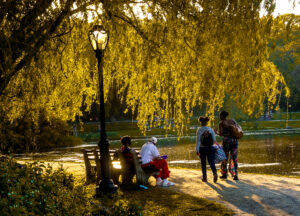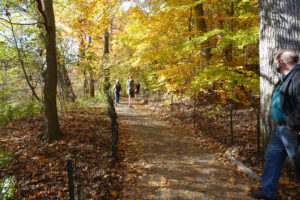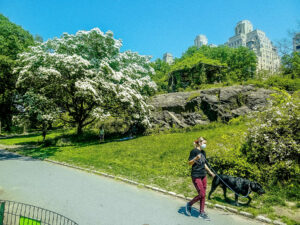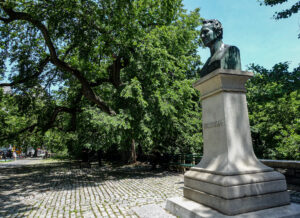Central Park Private Tour
Learn, explore, and have fun.
On your private tour, you will learn to love the park as I do. I live close to the North Woods and often in the park. Its beauty has been a balm and savior to my pandemic-addled soul. I conduct Central Park VIP Tours, and, at other times, I stroll randomly along its pastoral and picturesque paths. Over time I have learned to appreciate the trees I see. There is more of a story than you might expect about them. Very few are original. On our Central Park VIP tours, you will come to appreciate them as I do.

On October 17, 1858, the first trees ordered by Frederick Law Olmsted and Calvert Vaux, the park’s designers, arrived on site. Mr. Olmsted constantly battled with Andrew Haswell Green, the city controller, to procure the trees he envisioned for the site; the trees had to meet Mr. Olmsted’s rigorous standards.
Even if the trees were sub-standard, Mr. Green insisted that Olmsted use them anyway. Olmsted learned that the best way to deal with the situation was to have the trees immediately mulched. Mr. Green was furious, but there was only so much he could do except allow Olmsted to procure more suitable trees.
How many trees are in Central Park?
 Ultimately Olmsted planted 171 different tree species, totaling about twenty thousand trees. They planted Oaks, American Elms, Cherry, Tulips, Sycamores, London Plane, and Willows. Unlike the rocks I discussed in another blog, the trees are not as long-lived as expected. We often come upon recently downed trees on our Central Park tours. They lie sadly broken on their sides, slowly shedding their bark, trunks wretched dramatically and surprisingly from their roots. Over time they will decompose, but while they do, they provide habitats for various animals and plants.
Ultimately Olmsted planted 171 different tree species, totaling about twenty thousand trees. They planted Oaks, American Elms, Cherry, Tulips, Sycamores, London Plane, and Willows. Unlike the rocks I discussed in another blog, the trees are not as long-lived as expected. We often come upon recently downed trees on our Central Park tours. They lie sadly broken on their sides, slowly shedding their bark, trunks wretched dramatically and surprisingly from their roots. Over time they will decompose, but while they do, they provide habitats for various animals and plants.
Central Park Tornado.
Fourteen years ago, on August 18, 2009, a tornado ripped through the North Woods; it blew down five hundred trees and damaged about a thousand, including the two oldest and tallest sycamore trees. Trees do not last forever, and the park’s landscape changes constantly.
During the 1980s, the park suffered severe neglect; the Ramble and North Woods trees went rogue and seeded themselves; those specimens continue to grow today. On your Central Park VIP tour, your guide will discuss the efforts made by the Central Park Conservancy to restore the park to its original beauty. They have done a remarkable job, as you will see.
The Great Trees of Central Park
On the Central Park VIP tour, you will see some of the Great Trees in the park. My favorite tree in Central Park is the Humboldt Elm at the 77th & Central Park West Park entrance. This beauty is one of the oldest in the park; its branches reach high into the sky and drop gracefully down to brush the ground.
The Elm stands next to a bust of Friedrich von Humboldt (September 14, 1769 – May 6, 1859), a German polymath, geographer, naturalist, explorer, and proponent of Romantic philosophy and science. He is the first environmentalist. He understood that all of nature was connected and human actions affected the natural world. The tree is a fitting companion to this great scientist; he’d be honored.
Around the Pool in the park’s Northern section are stately willows, cypresses, tulip trees, elms, oaks, and others. Although trees provide shade and habitats for the numerous birds and other animals in the park, they also offer other not-so-obvious benefits.
The Lenni Lenape
The bark of the willow tree was used by the native people, the Lenni Lenape, to treat headaches, backaches, and inflammatory diseases. Later, scientists synthesized Salicylic acid from the tree, a precursor to aspirin. Other medicinal uses for the bark of this tree are as an anti-inflammatory agent, to stop bleeding, and to ease heartburn and stomach ailments. We’ll see Osage Orange and Yew trees; these trees still provide valuable wood and medicines.
On your private VIP tour, you can explore The Ramble, the North Woods, and the Hallett Conservatory.
The most stately and familiar trees are the American Elm. A blight wiped out most elm trees except in Central Park. On our Central Park tour, you will be privileged to stroll the Mall. Rising overhead on either side is the world’s largest stand of elm trees. This unique stand of trees will continue to shine their beauty upon us through careful cultivation and care.
Join us on a private Central Park VIP tour; you will be surprised and enchanted by what you see and learn.


